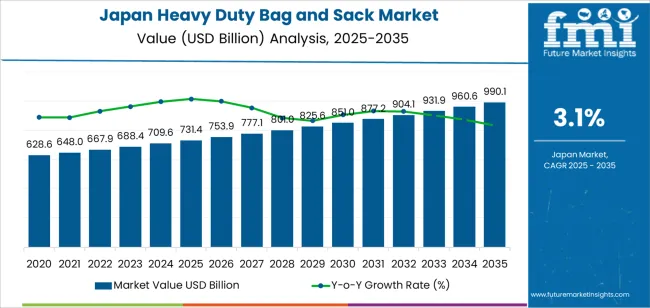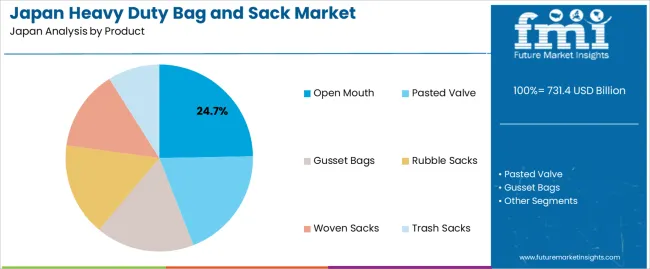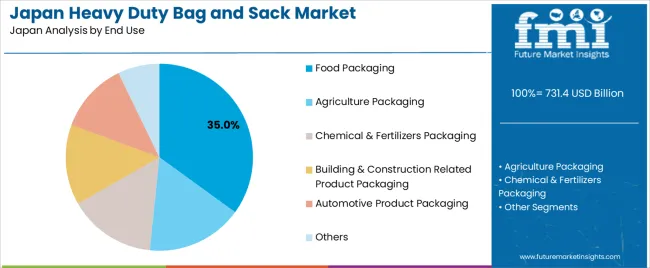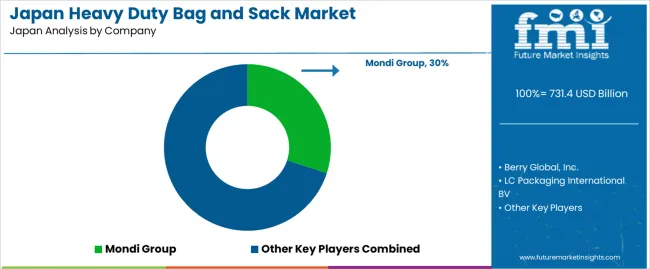The demand for heavy-duty bags and sacks in Japan is expected to grow from USD 731.4 million in 2025 to approximately USD 990.1 million by 2035, reflecting a CAGR of 3.1%. This growth is driven by the continued demand for strong, durable packaging solutions in various industries, including agriculture, construction, chemicals, and logistics. Heavy-duty bags and sacks are crucial for the storage and transportation of bulk goods, providing a cost-effective and efficient solution for industries that require reliable packaging. As Japan's industrial base continues to expand and evolve, the need for robust packaging materials will remain a key driver of industry growth. The rising demand for sustainable packaging options, alongside innovations in materials and design, will further contribute to the industry’s expansion.
The industry will also benefit from technological advancements in packaging materials, with an increasing focus on biodegradable, recyclable, and lightweight solutions. As industries adopt more environmentally friendly packaging methods, the demand for sustainable heavy-duty bags and sacks will rise. With Japan’s commitment to reducing environmental impact and improving resource efficiency, demand for eco-conscious, reusable packaging will continue to grow. This trend, alongside the continuing need for high-performance packaging in various sectors, will help drive the expansion of the heavy-duty bag and sack industry.

From 2025 to 2030, the industry will grow from USD 731.4 million to USD 851.0 million, adding USD 119.6 million in value. This phase is expected to account for a substantial portion of the overall industry growth, driven by the increased need for durable packaging in sectors such as construction, logistics, and agriculture. The growing demand for heavy-duty packaging solutions, combined with improvements in material technology and sustainability efforts, will play a significant role in this phase.
From 2030 to 2035, the industry will grow from USD 851.0 million to USD 990.1 million, contributing an additional USD 139.1 million in value. This period will see continued demand for heavy-duty bags and sacks as industries adopt more efficient, sustainable, and high-performance packaging materials. The expansion of recycling and eco-friendly practices across sectors will further fuel the industry's growth, with Japan continuing to focus on innovation in packaging solutions. Despite a maturing industry, the need for sustainable, durable, and cost-effective packaging will maintain strong demand for heavy-duty bags and sacks in the forecast period.
| Metric | Value |
|---|---|
| Demand for Heavy Duty Bag and Sack in Japan Value (2025) | USD 731.4 billion |
| Demand for Heavy Duty Bag and Sack in Japan Forecast Value (2035) | USD 990.1 billion |
| Demand for Heavy Duty Bag and Sack in Japan Forecast CAGR (2025 to 2035) | 3.1% |
The demand in Japan for heavy duty bags and sacks is increasing as industries such as agriculture, chemicals, construction, and bulk packaging seek more robust packaging formats. These bags and sacks are designed to handle heavier loads and harsher conditions than standard bags, making them essential for transporting bulk commodities, building materials, and industrial goods. As Japanese industry shifts toward higher productivity and larger‑scale logistics, the value of heavy‑duty packaging solutions rises.
Many sectors in Japan are upgrading their logistics and packaging infrastructure, which drives higher uptake of heavy‑duty bags and sacks. Consider the construction industry: bulk materials like cement, aggregates, and machinery parts require packaging solutions that provide strength, durability and ease of handling. The chemical and fertilizer sectors similarly rely on woven or multi‑layer sacks to safely transport and store powdered and granular materials. As these industries grow and diversify, the packaging requirements expand alongside.
Technological developments in material strength, manufacturing efficiency, and bag design are further supporting industry expansion. Innovations in woven fabrics, laminated films and reinforced closures add value by improving durability and reducing handling costs. As Japanese companies look for cost‑efficient and reliable packaging formats that meet industrial demands, the role of heavy‑duty bags and sacks is becoming more prominent and is expected to keep growing through 2035.
By product type, demand is divided into open mouth, pasted valve, gusset bags, rubble sacks, woven sacks, and trash sacks. In terms of end use, the industry is categorized into food packaging, agriculture packaging, chemical & fertilizers packaging, building & construction-related product packaging, automotive product packaging, and others. The demand is also segmented by capacity into less than 20 kg, 20-40 kg, and above 40 kg. In terms of material format, the industry is divided into plastic and jute. Regionally, demand is divided into Kanto, Kinki, Chubu, Kyushu & Okinawa, Tohoku, and the Rest of Japan.

Open mouth bags account for 25% of the demand for heavy duty bags and sacks in Japan. These bags are popular for their simplicity, ease of filling, and versatility across a wide range of industries. They are commonly used in packaging food products, chemicals, and agricultural goods due to their ability to handle large quantities of bulk materials efficiently. Open mouth bags are typically designed for manual or automated filling processes, offering flexibility in handling various products.
The demand for open mouth bags is driven by their cost-effectiveness and ability to be used across diverse industries. These bags are highly durable and provide adequate protection for products during storage and transportation. The versatility of open mouth bags makes them suitable for a wide range of applications, from food packaging to agriculture and construction products. As industries continue to prioritize cost-effective, flexible, and reliable packaging solutions, open mouth bags are expected to remain the dominant choice in the industry.

Food packaging accounts for 35% of the demand for heavy duty bags and sacks in Japan. The food industry relies heavily on durable and reliable packaging solutions to protect and preserve products during transportation, storage, and handling. Heavy duty bags and sacks are particularly popular in the packaging of bulk food items like grains, flour, sugar, and rice, as well as processed food products that require secure and hygienic storage.
The demand for heavy duty bags and sacks in food packaging is driven by the need for packaging solutions that can withstand harsh handling and ensure the safety and freshness of food products. As consumer demand for packaged and processed foods continues to grow, particularly in Japan's fast-paced retail environment, the need for robust, efficient, and cost-effective packaging solutions will drive further adoption of heavy duty bags. With the rising focus on sustainability and eco-friendly materials, packaging solutions that offer durability and protection for food items will remain a critical factor in the growth of this segment.
Key drivers include the need for stronger, more durable packaging solutions that handle heavier loads, bulk materials, and frequent transport, plus increased focus on recyclable or reusable packaging due to sustainability pressure. Japan’s advanced industrial base and high standards for packaging performance make these products important. Restraints include a relatively mature industrial packaging industry in Japan so growth tends to come from replacement/upgrade rather than new users plus rising raw-material costs (for plastics, woven fabrics, paper) and stronger regulation on single-use or non-recyclable packaging options.
In Japan, demand is growing because manufacturers, logistics firms and bulk-material users require packaging solutions that are reliable, space-efficient and cost-effective. Industries such as agriculture (bulk grain, fertilizer), chemicals (bulk granules/powders), construction (sand, aggregates, materials) and manufacturing (parts, modules) all rely on durable sacks and bags to move and store heavy loads safely. The emphasis on logistics efficiency in Japan where transport, storage space and handling must be highly optimized makes heavy-duty bags and sacks very attractive. Packaging sustainability concerns mean users are shifting from one-time crates or weak bags to stronger, reusable or heavier duty sacks, elevating demand.
Technological and product innovations are widening the appeal of heavy-duty bags and sacks in Japan. Better materials such as stronger woven plastic fabrics (HDPE/PP), laminated combinations, coated or moisture-resistant papers improve performance for challenging loads. Designs with improved discharge features, valve bags, open-mouth versions, gusseted shapes or modular stacking options adapt to transport/storage needs. Customisation (printing, UV-protection, colour coding) and supply-chain integration (flat-packed bags for return flows) support efficiency. Also, use of recycled materials or more environmentally friendly papers is appealing in Japan’s eco-conscious industry. These innovations reduce total cost of ownership and open new use-cases, thus supporting the growing demand.
Even with strong demand, several challenges slow broader adoption or growth in the Japanese industry. A major challenge is cost: heavier duty or premium bags often cost more upfront than simpler alternatives (basic sacks, bulk crates) which can deter smaller users or in lower-margin segments. Also, for extremely heavy or hazardous loads, users may still prefer metal or rigid containers, limiting substitution by sacks. Regulatory and sustainability pressures are increasing, but infrastructure (recycling, re-use flows for industrial sacks) may not yet be fully mature in all segments of Japan, so some buyers hesitate. Supply-chain issues such as raw-material price fluctuations, import-dependency for specialised fabrics or coatings can also increase risk for manufacturers and users alike.

| Region | CAGR (%) |
|---|---|
| Kyushu & Okinawa | 3.8% |
| Kanto | 3.5% |
| Kinki | 3.1% |
| Chubu | 2.7% |
| Tohoku | 2.4% |
| Rest of Japan | 2.3% |
The demand for heavy-duty bags and sacks in Japan is growing across all regions, with Kyushu & Okinawa leading at a 3.8% CAGR. This growth is driven by the increasing need for durable packaging in industries like agriculture, manufacturing, and logistics. Kanto follows closely with a 3.5% CAGR, supported by its strong industrial and consumer base. Kinki shows a 3.1% CAGR, driven by packaging demand in industrial sectors. Chubu experiences a 2.7% CAGR, influenced by its manufacturing focus. Tohoku and the Rest of Japan show moderate growth at 2.4% and 2.3%, respectively, as regional demand for heavy-duty packaging solutions continues to rise.
Kyushu & Okinawa is experiencing the highest demand for heavy-duty bags and sacks in Japan, with a 3.8% CAGR. The region's growing agricultural sector is a key driver, as heavy-duty bags are essential for packaging and transporting produce, grains, and other agricultural products. The expanding logistics and manufacturing industries are also contributing to the demand, as these industries require durable, high-capacity packaging solutions for bulk products.
Kyushu’s push towards improving its industrial and export sectors, particularly in agriculture and food processing, has led to an increased need for robust and efficient packaging like heavy-duty bags and sacks. Okinawa’s growing role in trade and tourism further supports the demand for packaging solutions, as industries look to streamline operations and improve efficiency. As the region continues to modernize its industrial practices and expand its agricultural exports, the demand for heavy-duty bags and sacks will continue to grow.

Kanto is witnessing strong growth in demand for heavy-duty bags and sacks, with a 3.5% CAGR. As the economic and industrial hub of Japan, Kanto, particularly Tokyo, has a high demand for packaging solutions across a wide range of industries. The region's strong presence in logistics, retail, and manufacturing is driving the need for durable and reliable packaging, such as heavy-duty bags and sacks, to handle large quantities of products.
The increasing demand for packaging in e-commerce and consumer goods sectors is also contributing to this growth, as companies look for cost-effective, sturdy packaging options to protect goods during transportation and storage. Kanto’s focus on improving logistics efficiency and reducing packaging waste is further supporting the adoption of heavy-duty packaging solutions. As industries continue to scale and modernize, the demand for heavy-duty bags and sacks in Kanto is expected to remain strong.
Kinki is experiencing steady demand for heavy-duty bags and sacks, with a 3.1% CAGR. The region, which includes major manufacturing centers like Osaka and Kyoto, is a key driver of demand due to its strong industrial base. Kinki’s automotive, chemical, and food processing sectors rely heavily on durable packaging solutions for the safe and efficient handling of bulk materials. As these industries continue to expand and modernize, the demand for heavy-duty bags and sacks is rising.
The region’s logistics sector, including the growth of e-commerce and warehousing industries, is also contributing to this demand. Heavy-duty bags and sacks are increasingly being used in distribution centers and retail packaging to manage bulk goods effectively. As Kinki continues to prioritize operational efficiency and cost-effective packaging solutions, the demand for heavy-duty bags and sacks is expected to remain steady in the coming years.

Chubu is seeing moderate growth in demand for heavy-duty bags and sacks, with a 2.7% CAGR. The region, home to industrial powerhouses like Nagoya, is experiencing increasing demand for robust packaging solutions as its manufacturing sectors expand. Heavy-duty bags and sacks are essential for handling large volumes of raw materials, automotive parts, and bulk goods in industries such as automotive, chemicals, and food processing.
The growth of logistics and e-commerce in Chubu is also contributing to the rising demand for durable packaging solutions. As more businesses invest in automation and improve their supply chain systems, the need for efficient, high-capacity packaging will continue to grow. While growth in Chubu is slower compared to other regions like Kyushu & Okinawa, its continued industrial development and focus on efficient logistics ensure steady demand for heavy-duty bags and sacks.
Tohoku is experiencing moderate growth in demand for heavy-duty bags and sacks, with a 2.4% CAGR. The region, which has a growing agricultural sector, is increasingly adopting heavy-duty bags for packaging and transporting agricultural products. As Tohoku continues to modernize its industrial infrastructure, the demand for durable and reliable packaging is rising.
The region’s focus on improving logistics and distribution systems, coupled with its expanding manufacturing base, is contributing to the increased use of heavy-duty bags and sacks in various sectors. As businesses in Tohoku seek to optimize packaging solutions for bulk materials, the demand for heavy-duty packaging will continue to grow. Although growth is slower than in more industrialized regions, the expansion of agricultural and manufacturing industries ensures steady demand for heavy-duty bags and sacks in Tohoku.
The Rest of Japan is seeing moderate growth in demand for heavy-duty bags and sacks, with a 2.3% CAGR. This includes rural and smaller urban areas where the adoption of industrial packaging solutions is gradually increasing. As businesses in these regions continue to modernize and expand, the need for durable packaging solutions like heavy-duty bags is growing.
The agriculture, manufacturing, and logistics sectors in the Rest of Japan are beginning to embrace more efficient packaging technologies to streamline operations and improve cost-effectiveness. With growing awareness of the benefits of high-quality, reliable packaging, the demand for heavy-duty bags and sacks is expected to increase. As these industries continue to adopt digital solutions and focus on improving operational efficiency, the Rest of Japan will see steady growth in the demand for heavy-duty bags and sacks.

Demand for heavy duty bags and sacks in Japan is rising as they are increasingly used in industrial packaging, construction material handling, agricultural bulk transport and chemical/fertilizer storage. These heavy duty sacks combine high‑load capacity, durability under harsh conditions and often weather‑ or UV‑resistance, enabling safe transportation and storage of bulky materials. As Japan’s infrastructure refurbishments, chemical exports and agricultural supply chains grow, demand for heavy duty bags and sacks expands. Challenges such as regulatory pressure on plastic usage, rising costs of raw materials and competition from alternative packaging formats remain.
In the Japanese competitive landscape one leading provider is Mondi Group with an estimated share of approximately 30.0 %. Other significant participants include Berry Global, Inc., LC Packaging International BV, Muscat Polymers Pvt. Ltd., Al‑Tawfiq Company and Inteplast Group each offering specialized high‑strength sack solutions and tailored services for Japan’s suppliers and converters.
Key drivers in Japan include increasing demand for bulk packaging driven by construction, chemicals and agriculture sectors, growth in imports and exports of raw materials that use woven or film‑based sacks, and technical improvements such as lighter weight materials and higher strength films enabling cost savings. Challenges persist such as tightening regulations on single‑use plastics, the need to shift toward recyclable or bio‑based materials, and the pressure on manufacturers and users to optimise lifecycle cost and environmental footprint.
| Items | Values |
|---|---|
| Quantitative Unit | USD billion |
| Product Type | Open Mouth, Pasted Valve, Gusset Bags, Rubble Sacks, Woven Sacks, Trash Sacks |
| Material Format | Plastic, Jute |
| Capacity | Less than 20 kg, 20-40 kg, Above 40 kg |
| End Use | Food Packaging, Agriculture Packaging, Chemical & Fertilizers Packaging, Building & Construction Product Packaging, Automotive Product Packaging, Others |
| Regions Covered | Kyushu & Okinawa, Kanto, Kinki, Chubu, Tohoku, Rest of Japan |
| Key Players Profiled | Mondi Group, Berry Global, Inc., LC Packaging International BV, Muscat Polymers Pvt. Ltd., Al-Tawfiq Company, Inteplast Group |
| Additional Attributes | Dollar sales by product type, material format, capacity, end use, and regional trends with a focus on packaging sectors in food, agriculture, and chemicals |
The demand for heavy duty bag and sack in Japan is estimated to be valued at USD 731.4 billion in 2025.
The market size for the heavy duty bag and sack in Japan is projected to reach USD 990.1 billion by 2035.
The demand for heavy duty bag and sack in Japan is expected to grow at a 3.1% CAGR between 2025 and 2035.
The key product types in heavy duty bag and sack in Japan are open mouth, pasted valve, gusset bags, rubble sacks, woven sacks and trash sacks.
In terms of material format, plastic segment is expected to command 53.7% share in the heavy duty bag and sack in Japan in 2025.






Our Research Products

The "Full Research Suite" delivers actionable market intel, deep dives on markets or technologies, so clients act faster, cut risk, and unlock growth.

The Leaderboard benchmarks and ranks top vendors, classifying them as Established Leaders, Leading Challengers, or Disruptors & Challengers.

Locates where complements amplify value and substitutes erode it, forecasting net impact by horizon

We deliver granular, decision-grade intel: market sizing, 5-year forecasts, pricing, adoption, usage, revenue, and operational KPIs—plus competitor tracking, regulation, and value chains—across 60 countries broadly.

Spot the shifts before they hit your P&L. We track inflection points, adoption curves, pricing moves, and ecosystem plays to show where demand is heading, why it is changing, and what to do next across high-growth markets and disruptive tech

Real-time reads of user behavior. We track shifting priorities, perceptions of today’s and next-gen services, and provider experience, then pace how fast tech moves from trial to adoption, blending buyer, consumer, and channel inputs with social signals (#WhySwitch, #UX).

Partner with our analyst team to build a custom report designed around your business priorities. From analysing market trends to assessing competitors or crafting bespoke datasets, we tailor insights to your needs.
Supplier Intelligence
Discovery & Profiling
Capacity & Footprint
Performance & Risk
Compliance & Governance
Commercial Readiness
Who Supplies Whom
Scorecards & Shortlists
Playbooks & Docs
Category Intelligence
Definition & Scope
Demand & Use Cases
Cost Drivers
Market Structure
Supply Chain Map
Trade & Policy
Operating Norms
Deliverables
Buyer Intelligence
Account Basics
Spend & Scope
Procurement Model
Vendor Requirements
Terms & Policies
Entry Strategy
Pain Points & Triggers
Outputs
Pricing Analysis
Benchmarks
Trends
Should-Cost
Indexation
Landed Cost
Commercial Terms
Deliverables
Brand Analysis
Positioning & Value Prop
Share & Presence
Customer Evidence
Go-to-Market
Digital & Reputation
Compliance & Trust
KPIs & Gaps
Outputs
Full Research Suite comprises of:
Market outlook & trends analysis
Interviews & case studies
Strategic recommendations
Vendor profiles & capabilities analysis
5-year forecasts
8 regions and 60+ country-level data splits
Market segment data splits
12 months of continuous data updates
DELIVERED AS:
PDF EXCEL ONLINE
Demand Signal Repository Solutions Market Size and Share Forecast Outlook 2025 to 2035
Demand Side Management Market Size and Share Forecast Outlook 2025 to 2035
Demand Response Market Analysis - Size, Share, and Forecast Outlook 2025 to 2035
North America Shipping Supplies Market Trends – Innovations & Growth 2024-2034
Demand of Kozani Saffron in Greece Analysis - Size, Share & Forecast 2025 to 2035
Demand of No-acid Whey Strained Dairy Processing Concepts in European Union Size and Share Forecast Outlook 2025 to 2035
Demand for Bronte Pistachio in Italy Analysis - Size, Share & Forecast 2025 to 2035
Demand and Trend Analysis of Gaming Monitor in Western Europe Size and Share Forecast Outlook 2025 to 2035
Demand and Trend Analysis of Gaming Monitor in Korea Size and Share Forecast Outlook 2025 to 2035
Demand and Trend Analysis of Gaming Monitor in Japan Size and Share Forecast Outlook 2025 to 2035
Glycine Soja (Soybean) Seed Extract Market Size and Share Forecast Outlook 2025 to 2035
Demand and Trend Analysis of Yeast in Japan - Size, Share, and Forecast Outlook 2025 to 2035
Demand of Pistachio-based desserts & ingredients in France Analysis - Size, Share & Forecast 2025 to 2035
Western Europe Men’s Skincare Market Analysis – Forecast 2023-2033
Demand and Trends Analysis of Stevia in Japan Size and Share Forecast Outlook 2025 to 2035
Japan Women’s Intimate Care Market Trends – Growth & Forecast 2024-2034
Demand and Trend Analysis of Fabric Stain Remover in Korea Size and Share Forecast Outlook 2025 to 2035
Demand and Sales Analysis of Paper Cup in Korea Size and Share Forecast Outlook 2025 to 2035
Demand and Sales Analysis of Paper Cup in Western Europe Size and Share Forecast Outlook 2025 to 2035
Demand of MFGM-enriched Powders & RTDs in European Union Size and Share Forecast Outlook 2025 to 2035

Thank you!
You will receive an email from our Business Development Manager. Please be sure to check your SPAM/JUNK folder too.
Chat With
MaRIA